- Tablet Dissolution Testing Instruments
- Offline Automated Dissolution Systems
- Online Automated Dissolution Systems
- In-Situ Dissolution Testing (Coming Soon)
- Media Preparation
- UV/VIS Spectrometers

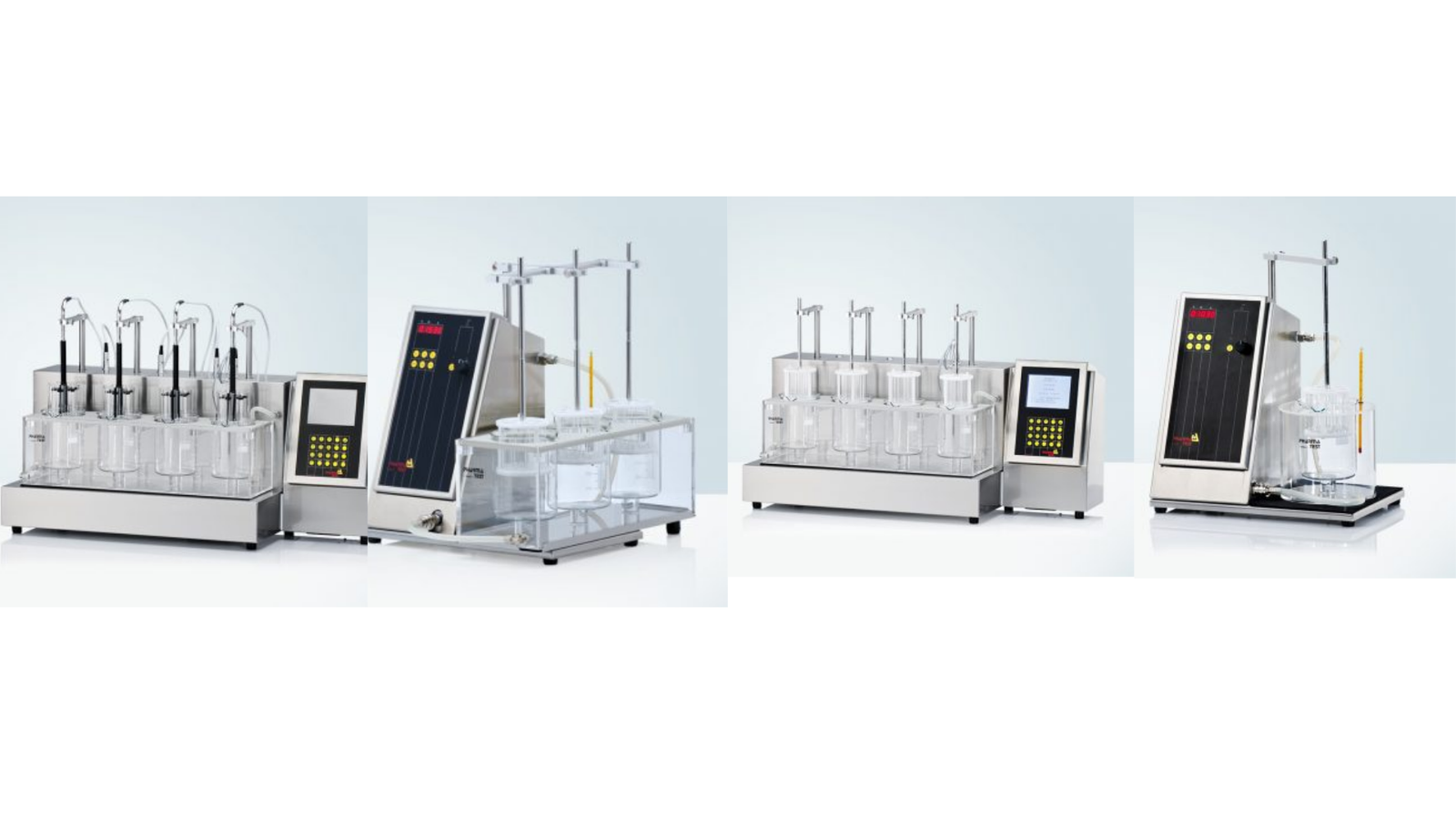
Tablet Disintegration Testing Instruments
Tablet disintegration testing instruments are widely used in the pharmaceutical industry to evaluate the disintegration characteristics of formulations and the quality control of different dosage forms.
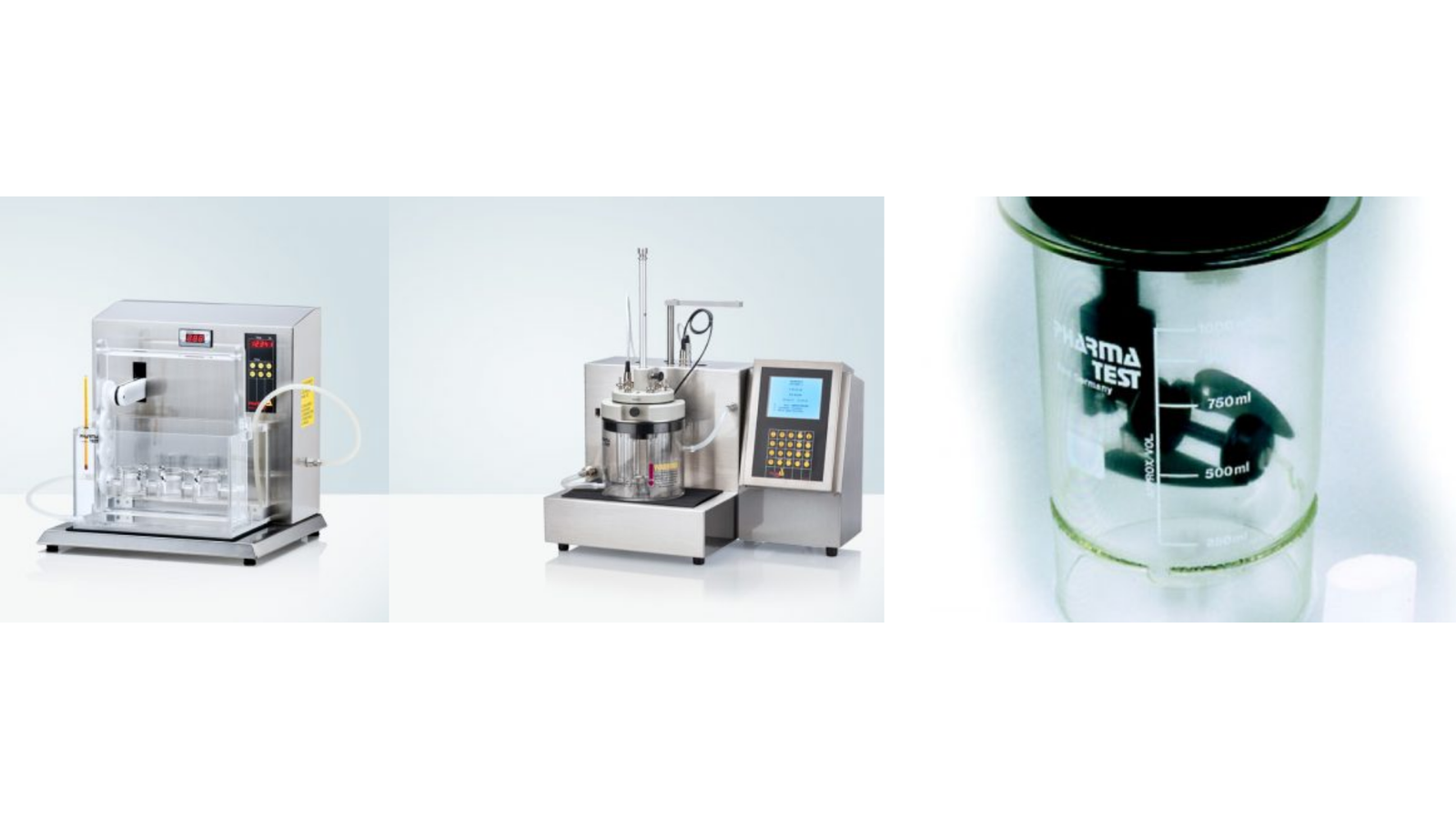
Suppository Testing Instruments
This range of instruments to test the quality of suppositories, pessaries and creams includes disintegration and penetration testers.

Tablet Hardness Testing Instruments
Tablet hardness testing is used to test the breaking point and structural integrity of a tablet prior to storage, transportation, and handling before usage.

Ampoule Testing Instruments
Many liquid drugs are delivered in ampoules.We offer a fully DIN/ISO 9187 compliant solution to test the hardness of empty ampoules at line during production.
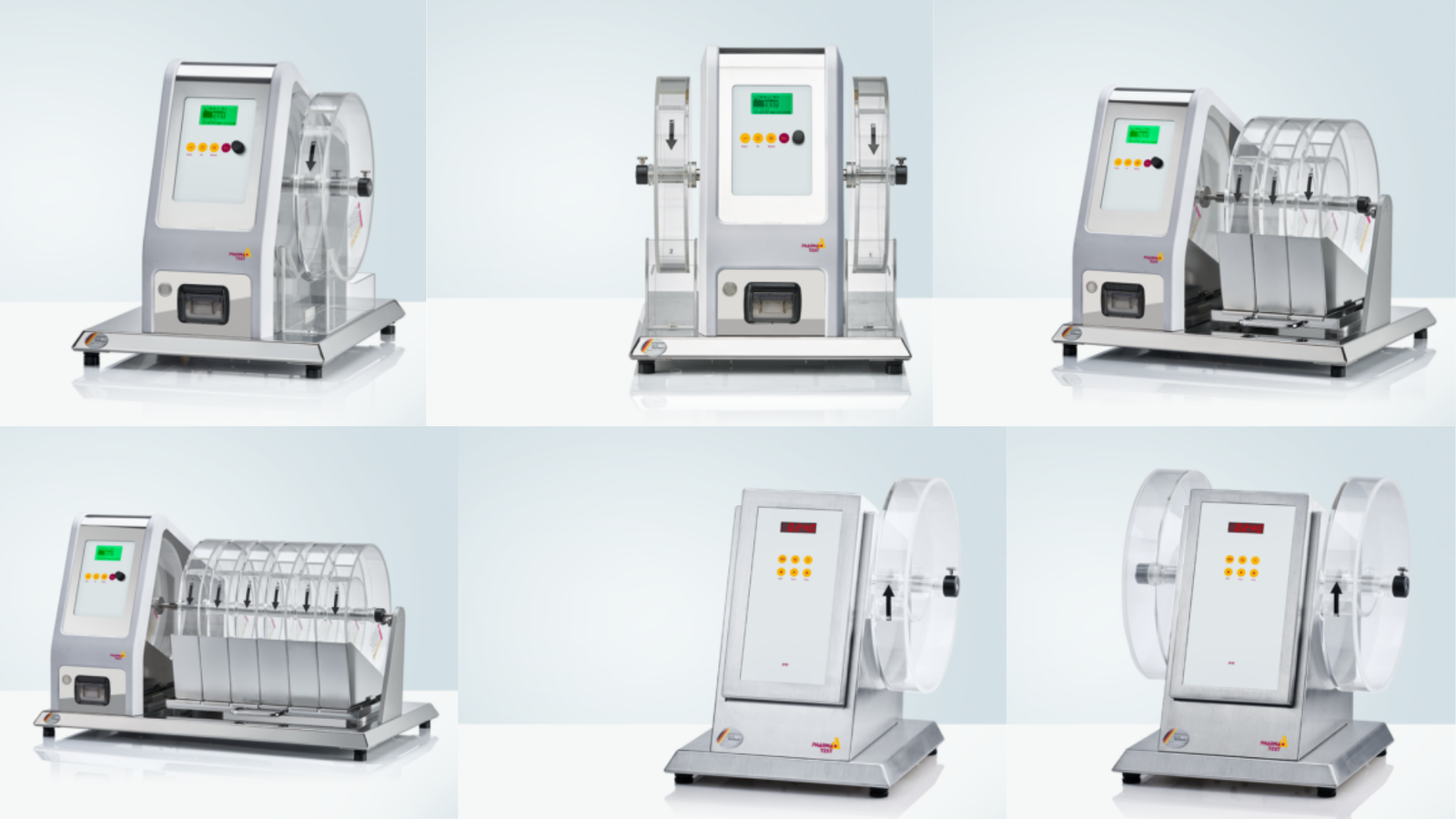
Tablet Friability Testing Instruments
Friability testing is used to test the durability of tablets during packing processes and transit. This involves repeatedly dropping a sample of tablets over a fixed time, using a rotating drum with a baffle.
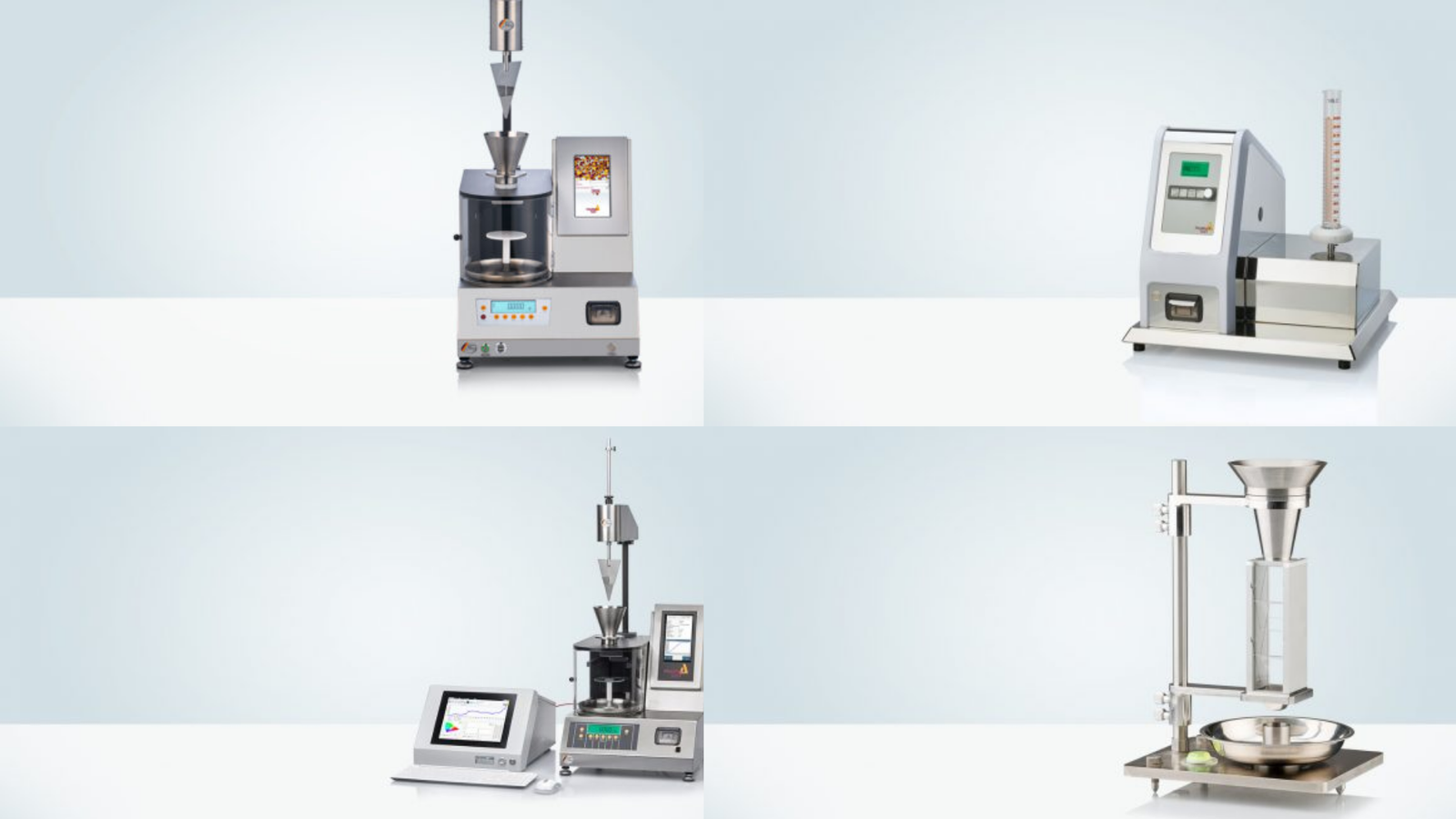
Powder Testing Instruments
The Pharma Test powder testing product portfolio includes instruments to not only measure bulk density but also tap density and flowability.

Leak Testing Instruments
The leak test apparatus is used in the pharmaceutical industry to check the integrity of tablet strips, blister packs and small bottles.
WHT 4

Fully Automated 4-in-1 Tablet Testing Instrument
Test weight, thickness (or height), diameter (or length), and hardness of regular tablets, odd shaped tablets (caplets, oblongs etc.) and other solid samples fully automatically. Use the WHT 4 for the fully automated testing of single tablet critical parameters including weight (in compliance to the European and German Pharmacopoeia for uniformity of mass), thickness, diameter and the tablet hardness also according to the European EP <2.9.8> and USP <1217> Pharmacopoeia.
The main features of the WHT 4 instrument are:
>Tablet hardness testing in full compliance to USP <1217> and EP <2.9.8> Pharmacopeia
>4 results of the same sample: thickness, diameter, hardness and weight (via internal balance)
>Complete system of instrument, PC and software
>Dual force mode instrument with linear speed increase and linear force increase modes
>Multiple point validation procedure for all measurement stations built-in
The main features of the WHT32 software package are:
>Product dependent method description including number of tests to be done within each testing station, T1 and T2 tolerance classification, plausibility rejection, selectable measuring units and adjustable measuring parameters
>Statistical calculations of mean value, absolute and relative standard deviations, minimum and maximum result
>Batch comparison statistics
>Networking capabilities (optional)
>Features a robust SQL MS Jet database
>User and password and login administration (21CFR part11 option)
>Audit trail and data path selection (21CFR part 11 option)
>Calibration programs for each testing station (requires calibration tools, such as reference blocks, weights etc.)
>Result data transfer via RS-232 data interface
>Microsoft Excel and LIMS export functionalities (optional)
>Software IQ and OQ documentation available
| Parameter | Specification |
| Number of Testing Stations | 4 (Hardness, Thickness, Diameter and Weight) |
| Hardness Testing Range | 5.0 – 500.0 N (optional 2.0 – 300.0 N, 10.0 – 1,000.0 N) |
| Hardness Accuracy | Better than 1N |
| Thickness Testing Range | 1.00 – 20.00mm |
| Thickness Accuracy | Better than ±0.02mm |
| Diameter Testing Range | 2.00 – 30.00mm |
| Diameter Accuracy | Better than ±0.02mm |
| Weight Measurement | By internal Sartorius balance cell |
| Weight Testing Range | 0.0001g – 200.0000g |
| Weight Accuracy | 0.1mg |
| Force Mode | Selectable between linear force increase and constant speed |
| Force Rate: lin. force | 5 – 250 N/sec. (linear force increase) |
| Force Rate: constant speed | 5 – 250 mm/Min. (constant speed) |
| Industrial PC (IPC) | Integrated high resolution color touch screen PC |
| Sample Handling | Semi- or fully automated using single or multi-batch feeder |
| Testing Speed | 10 to 15 tests per minute depending on sample hardness |
| Flap Control | Flap speed and opening angle steplessly adjustable |
| Number of Tests | Up to 250 tests in one test run |
| Measuring Units | Thickness and diameter selectable between millimeter (mm) and inches (IN) Hardness selectable between Newton (N), Kilopond (kp) and Strong Cobb (Sc) |
| Calibration Procedure | Using certified 1-30 mm reference blocks, 50g (for balance) and 5 to 50kg (for load cell) reference weights |
| Break Force Validation | Using the PT-MT3 magnetic tablet at 10 to 480N |
| Interfaces | 2x USB, 2x LAN, RS232, DVI, Bluetooth |
| Printer Support | Supports any Windows compatible printer via USB or LAN |
| Instrument Housing | Stainless steel (304) to meet GLP requirements |
| Power | 110/230 Volt, 50/60 Hz |
| Packaging Dimensions | Approx. 90cm x 65cm x 75cm (D x W x H); approx. 118cm x 76cm x 70cm incl. WHT 4-SM |
| Net / Gross Weight | Approx. 45 / 70 kg |
| Net / Gross Weight | Approx. 73 / 105 kg incl. WHT 4-SM |
| Certification | All components certified to USP / EP requirements |
| CE / EMC Certification | All CE / EMC Certification provided |
| Validation | All IQ & OQ documents included |
The WHT 4 comes ready to use with the following standard scope of supply:
>WHT 4 instrument
>Touch screen industrial PC connected by swivel arm
>WHT32 software package (standard version)
>A set of 3, 5 and 10mm reference blocks
>Comprehensive documentation folder including:
>User manual
>IQ documentation
>OQ documentation
>Instrument logbook
SPT-6
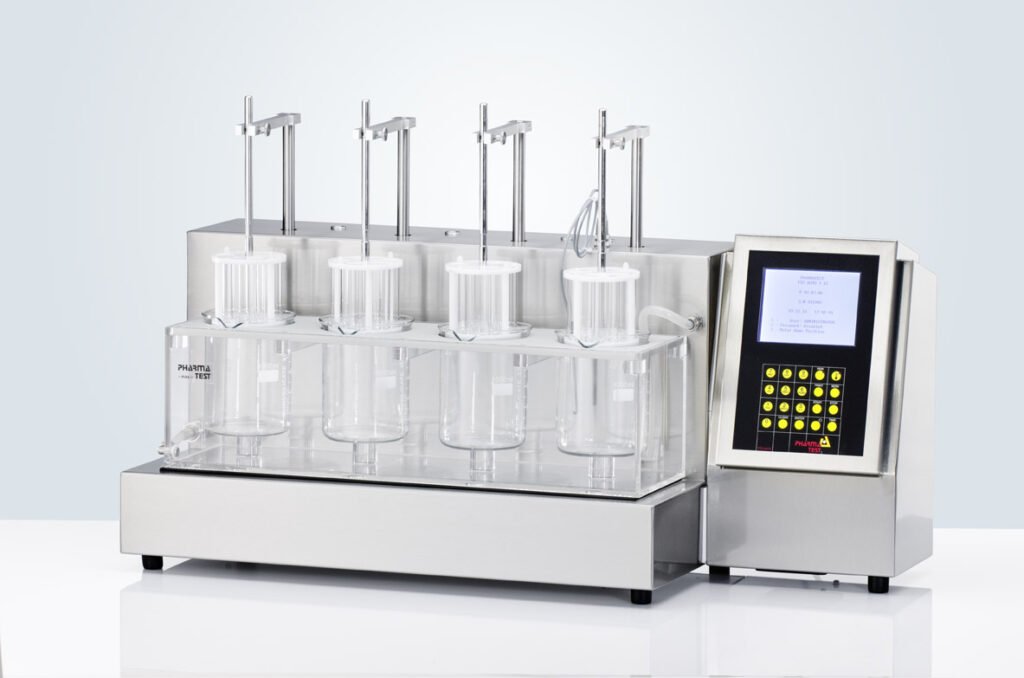
Suppository Penetration Test Assembly
The SPT-6 Suppository Penetration Test assembly is used to determine the softening time of six samples at the same time. It is connected to a Pharma Test PTZ AUTO or PTZ-S tablet disintegration test instrument. The SPT-6 assembly can also be immersed into a suitable water bath. The SPT-6 is made in strict compliance with EP <2.9.22> Apparatus <A>. The assembly is placed into its own single position Plexiglas water bath. This way it is possible to use the SPT-6 in either a PTZ AUTO 1-4, PTZ AUTO 1EZ-4EZ or a PTZ-S tablet disintegration test instrument.
>Fully EP <2.9.22.1> Apparatus A compliant
>Test six samples at the same time
>Connect to any PTZ-S, DIST-3, PTZ AUTO 1-4 or PTZ AUTO 1EZ – 4EZ instrument
>Supply scope includes water bath and tubing connection to heating system of disintegration testing instrument
Advantages
>Fully automated detection of suppository softening time (with PTZ AUTO EZ only)
>Round, clear-view waterbath for excellent visibility of all samples
>Multi-purpose system: the disintegration testing instrument can still be used for regular tablet disintegration tests
>IQ/OQ documents included free of charge
| Parameter | Specification |
| Number of Glass Tubes | 6 glass tubes 5.2 mm diameter – 140 mm length |
| Number of Test Rods | 6 test rods, total weight each 30 ± 0.1g |
| Additional Equipment needed | Thermostat to heat the water bath, or PTZS/PTZAUTO Disintegration Test Instrument to connect the water bath |
| Packaging dimensions | Approx. 500 x 500 x 400 mm (width x depth x height) |
| Net / Gross Weight | Approx. 8 / 12 kg |
Included in the Standard Scope of Supply
>Glass tube for SPT-6 (part. no. 392-0010)
>Test rod for SPT-6 (part. no. 392-0011)
>Plexiglas water bath, without cover and tubing (part. no. 101-0215)
>Control thermometer 1HN11 -10/+50°C, not calibrated (part. no. 105-0801)
>Supporting shaft (part. no. 392-0100)
PTB 420
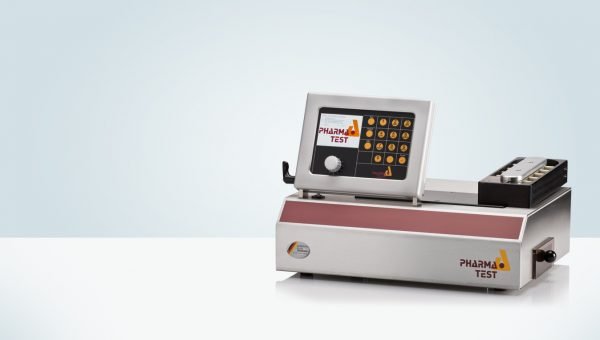
Automated Hardness Test Instrument with Balance Connection
The automated tablet testing instrument PTB 420 is a dual test mode instrument to determine the diameter, thickness and hardness of tablets. The instrument is made in strict compliance with the EP <2.9.8> and USP <1217> Pharmacopoeia.
>Tablet hardness testing in full compliance to USP <1217> and EP <2.9.8> Pharmacopeia
>4 results of the same sample: thickness, diameter, hardness and weight (via connected external analytical balance)
>Dual force mode instrument with linear speed increase and linear force increase modes
>Steppless adjustment of the linear force or speed increase rate
>Document all results on external printer
>Multiple point validation procedure for all measurement stations built-in
>Programmable print-out of force increase curve
| Parameter | Specification |
| Hardness Testing Range | 5.0 – 500.0N (optional 10.0 – 1,000.0N) |
| Hardness Accuracy | Better than 1N |
| Thickness Testing Range | 2.00 – 12.00mm |
| Thickness Accuracy | Better than ±0.05mm |
| Diameter Testing Range | 2.00 – 30.00mm without magazine |
| Possible Sample Size (When Using a Magazine) | length max. 25mm, width/diameter max. 20mm |
| Diameter Accuracy | Better than ±0.05mm |
| Weight Measurement | by using a connected, external Mettler-Toledo or Sartorius balance (balance not included in standard supply scope), the individual or average weight can be recognized and automatically transferred to the PTB420. |
| Weight Testing Range | 0.0001g – 99.9999g |
| Measuring Units | Thickness and diameter selectable between millimeter [mm] (factory setting) and inches [In] Hardness selectable between Newton [N] (factory setting), Kilopond [kp] and Strong Cobb [Sc] |
| Force Mode | Selectable between linear force increase and constant speed |
| Force Rate: lin. force | 5 – 200 N/sec. |
| Force Rate: constant speed | 5 – 250 mm/Min. |
| Display | Back-lit color LCD |
| Keyboard | Alpha-numeric keypad and click wheel |
| User Settings User / Passwords Methods Procedures Products | Memory for user defined settings: up to 50 up to 200 up to 100 up to 100 |
| Feeder | Tablet magazine for 10 samples available (optional) |
| Laser Type | Class 1 |
| Interface |
|
| Instrument Housing | Stainless steel (304) to meet GLP requirements |
| Power | 110/230 Volt AC, 50/60 Hz |
| Current Consumption | 0,25A at 230V; 0,5A at 115V; 60W |
| Main Fuse | 2 x T2,0A |
| Grade of Pollution | 2 |
| Operational Altitude | 0 – 2000 m; 0 – 6500 ft |
| Installation Requirements | » Ambient Temperature 10-40°C » Relative Humidity 20-90%rH » Desk with at least 50 kg working load. All around the instrument at least 10cm free distance to walls or other equipment. Free access to the mains power plug and switch. No special ventilation necessary. |
| Use of Corrosive Materials | 0,1 NHCL approved, no other solvents permitted, see cleaning instructions. Possible residues must be removed immediately (see “Cleaning Instructions”) |
| Instrument Dimensions | approx. 400 x 530 x 400 mm (Length x Width x Height) |
| Packaging Dimensions | approx. 500 x 590 x 440 mm (Length x Width x Height) |
| Net / Gross Weight | approx. 20 kg / 30 kg (without optional asseccories) |
| Certification | All components certified to USP / EP requirements |
| CE / EMC Certification | All CE / EMC Certification provided |
| Validation | All IQ & OQ documents included |
Included in the Standard Scope of Supply
>PTB 420 instrument
>A set of 3, 5 and 10mm reference blocks
>Comprehensive documentation folder including:
>User manual
>QC/DQ testing certificate
>IQ documentation
>OQ documentation
>Conformity Declaration
>CE/EMC Declaration
>Instrument logbook
PTB 420 Auto

Fully Automated 4-in-1 Tablet Testing Instrument
The fully automated 4-in-1 tablet testing instrument PTB 420 Auto is a dual test mode instrument to determine the weight, diameter, thickness and hardness of tablets. The instrument is made in strict compliance with the EP <2.9.8> and USP <1217> Pharmacopoeia.
>Tablet hardness testing in full compliance to USP <1217> and EP <2.9.8> Pharmacopeia
>4 results of the same sample: thickness, diameter, hardness and weight (via integrated Sartorius analytical balance)
>Dual force mode instrument with linear speed increase and linear force increase modes
>Stepless adjustment of the linear force or speed increase rate
>Document all results on external printer
>Multiple point validation procedure for all measurement stations built-in
>Programmable print-out of force increase curve
Advantages
>Test up to 25 samples fully automatically by using the integrated feeder; feeder can be refilled at all times for more than 25 samples in one test
>Automatically determine the individual sample weights using the integrated Sartorius analytical balance
>Automated positioning of samples in the testing area by unique alignment jaws
>Touch-less measurement of sample thickness
>Sophisticated user and method management system included
>Quick start functionality to start testing with minimal preparation
>Quick menu navigation by using a large color LCD and a click wheel
>Select either linear force or linear speed increase (dual mode selection)
>Entry of time and date
>Enter a 12 digit batch number
>Dual point adjustment of the load cell for the hardness test station
>Multiple point validation (calibration)
>Hardness testing in compliance with the EP <2.9.8> and USP <1217> Pharmacopoeia
>IQ/OQ documents included free of charge
| Parameter | Specification |
| Hardness Testing Range | 5.0 – 500.0N (optional 10.0 – 1,000.0N) |
| Hardness Accuracy | Better than 1N |
| Thickness Testing Range | 2.00 – 12.00mm |
| Thickness Accuracy | Better than ±0.05mm |
| Diameter Testing Range | 2.00 – 30.00mm without magazine |
| Possible Sample Size | 22.00 mm x 33.00 mm |
| Diameter Accuracy | Better than ±0.05mm |
| Weight Measurement | has an integrated Sartorius balance |
| Weight Testing Range | 0.0001g – 99.9999g |
| Measuring Units | Thickness and diameter selectable between millimeter [mm] (factory setting) and inches [In] Hardness selectable between Newton [N] (factory setting), Kilopond [kp] and Strong Cobb [Sc] |
| Force Mode | Selectable between linear force increase and constant speed |
| Force Rate: lin. force | 5 – 200 N/sec |
| Force Rate: constant speed | 5 – 250 mm/Min |
| Display | Back-lit color LCD |
| Keyboard | Alpha-numeric keypad and click wheel |
| User Settings User / Passwords Methods Procedures Products | Memory for user defined settings: up to 50 up to 200 up to 100 up to 100 |
| Feeder | Tablet magazine for 25 samples (integrated) |
| Laser Type | Class 1 |
| Interface | » RS232 serial port to connect a Mettler-Toledo or Sartorius balance » Parallel port for printer connection » RS232 port for PC connection » USB port for firmware updates » All interface ports match the SELV- (save extra low voltage) codes. All additional instruments (printer, balance…) plugged to the PTB 420 Auto must also match the SELV-codes. |
| Instrument Housing | Stainless steel (304) to meet GLP requirements |
| Power | 110/230 Volt AC, 50/60 Hz |
| Current Consumption | 0,25A at 230V; 0,5A at 115V; 60W |
| Main Fuse | 2 x T2,0A |
| Grade of Pollution | 2 |
| Operational Altitude | 0 – 2000 m; 0 – 6500 ft |
| Installation Requirements | » Ambient Temperature 10-40°C » Relative Humidity 20-90%rH » Desk with at least 50 kg working load. All around the instrument at least 10cm free distance to walls or other equipment. Free access to the mains power plug and switch. No special ventilation necessary. |
| Use of Corrosive Materials | 0,1 NHCL approved, no other solvents permitted, see cleaning instructions. Possible residues must be removed immediately (see “Cleaning Instructions”) |
| Instrument Dimensions | approx. 400 x 530 x 400 mm (Length x Width x Height) |
| Packaging Dimensions | approx. 500 x 590 x 440 mm (Length x Width x Height) |
| Net / Gross Weight | approx. 20 kg / 30kg (without optional asseccories) |
| Certification | All components certified to USP / EP requirements |
| CE / EMC Certification | All CE / EMC Certification provided |
| Validation | All IQ & OQ documents included |
Included in the Standard Scope of Supply
>PTB 420 Auto instrument including feeder and balance module
>A set of 3, 5 and 10mm reference blocks
>Comprehensive documentation folder including:
>User manual
>QC/DQ testing certificate
>IQ documentation
>OQ documentation
>Conformity Declaration
>CE/EMC Declaration
>Instrument logbook
PTB 311E / 511E / 311E-800

Manual 3-in-1 Tablet Testing Instrument
The manual tablet testing instrument PTB 311E/511E/311E-800 is a dual force mode hardness test apparatus as it can be used for either linear force or linear speed increase while tablet hardness is tested. It offers a multiple point validation procedure for the built-in digital load cell. The instrument is made in strict compliance with the EP <2.9.8> and USP <1217> Pharmacopoeia.
>Fully USP <1217> and EP <2.9.8> compliant
>Dual force mode instrument with linear speed increase and linear force increase modes
>Multiple point validation procedure built-in
>Programmable print-out of force increase curve
>Set to test tension strength of oblongs and caplets available
Advantages
>Select either linear force or linear speed increase (dual mode selection)
>Stepless adjustment of the force or speed increasing rate
>Entry of time and date
>Enter a 12 digit batch number
>Automatic re-start facility to speed up the testing sequence
>Documentation of all results using a separate Dot-Matrix or PCL5 printer
>Validation and calibration program for the measurement station
>Force curve print-out
>Dual point adjustment of the load cell for the hardness test station
>Multiple point validation (calibration) up to 30 or 50kg
>Programmable print-out of force increase curve
>Data transfer via RS-232 interface
>Hardness testing in compliance with the EP <2.9.8> and USP <1217> Pharmacopoeia
>Test program for soft gelatine capsule testing by setting up a testing distance
| Parameter | Specification |
| Hardness Testing Range | PTB311E: 5.0 – 300.0 N ± 10 N PTB511E: 10.0 – 500.0 N ± 50 N PTB311E-800: 10.0 – 800.0 N ± 50 N |
| Hardness Accuracy | Better than ±1 N |
| Hardness Resolution | 0.1 N |
| Thickness Testing Range | 2.00 – 45.00 mm |
| Thickness Accuracy | Better than ±0.02 mm |
| Diameter Testing Range | 2.00 – 45.00 mm |
| Diameter Accuracy | Better than ±0.02 mm |
| Thickness & Diameter Resolution | 0.01 mm |
| Measuring Units | Thickness and diameter selectable between millimeter (mm) and inches (IN) Hardness selectable between Newton (N), Kilopond (kp) and Strong Cobb (Sc) |
| Force Mode | Selectable: linear force increase or linear speed increase |
| Force Rate | PTB311E and PTB511E: 5 – 200 N/sec. (linear force increase); PTB311E-800: 10 – 200 N/sec. (linear force increase) or 5 – 200mm/Min. (linear speed increase) |
| Interface | RS232 serial port to connect a PC or Epson TM-U220B ticket printer Parallel port for A4 printer connection |
| Instrument Housing | Stainless steel (304) to meet GLP requirements |
| Power | 115 Volt AC or 230 Volt AC, 50/60 Hz |
| Current Consumption | 0,15 A at 230 V; 0,30 A at 115 V; 35 W |
| Main Fuse | 2 x T1,0 A |
| Installation Requirements | Ambient Temperature 15-35 °C Relative Humidity 15-80 %rH Desk with at least 50 kg working load. All around the instrument at least 10 cm free distance to walls or other equipment. Free access to the mains power plug and switch. |
| Instrument Dimensions | Approx. 260 x 500 x 260 mm (Length x Width x Height) |
| Packaging Dimensions | Approx. 310 x 660 x 420 mm (Length x Width x Height) |
| Net / Gross Weight | Approx. 9,5 kg / 12,5 kg (without optional accessories) |
| Certification | All components certified to USP / EP requirements |
| CE / EMC Certification | All CE / EMC Certification provided |
| Validation | All IQ & OQ documents included |
Included in the Standard Scope of Supply
The PTB111EP / 111EP-500 / 111EP-800 comes ready to use with the following standard scope of supply:
- Standard jaw set size 4 to allow hardness test of all size and shape samples
- Broken sample collector
- 10 rolls of printer paper
- Comprehensive documentation folder including:
- User manual
- QC/DQ testing certificate
- IQ documentation
- OQ documentation
- Conformity Declaration
- CE/EMC Declaration
- Instrument logbook
PTB 111EP

Manual Tablet Hardness Testing Instrument with Integrated Report Printer
The manual tablet hardness testing instrument PTB111EP / 111EP-500 / 111EP-800 features an integrated report printer. It is a dual force mode hardness test apparatus as it can be used for either linear force or linear speed increase while tablet hardness is tested. It offers a multiple point validation procedure for the built-in digital load cell. The instrument is made in strict compliance with the EP <2.9.8> and USP <1217> Pharmacopoeia.
>Fully USP <1217> and EP <2.9.8> compliant
>Dual force mode instrument with linear speed increase and linear force increase modes
>Stepless adjustment of the linear force or speed increase rate
>Integrated thermal printer
>Multiple point validation procedure built-in
>Programmable print-out of force increase curve
Advantages
>No external printer required, this reduces the necessary bench space
>Documentation of all results using an integrated report printer
>Report printer uses less paper compared to a standard A4 format printer
>Select either linear force or linear speed increase (dual mode selection)
>Entry of time and date
>Enter a 12 digit batch number
>Automatic re-start facility to speed up the testing sequence
>Validation and calibration program for the measurement station
>Force curve print out
>Dual point adjustment of the load cell for the hardness test station
>Multiple point validation (calibration)
>Programmable print-out of force increase curve
>Data transfer via RS-232 interface
>Hardness testing in compliance with the EP <2.9.8> and USP <1217> Pharmacopoeia
>Test program for soft gelatine capsule testing by setting up a testing distance
>Set to test tension strength of oblongs and caplets available
| Parameter | Specification |
| Hardness Testing Range | PTB111EP: 5.0 – 300.0 N ± 2 N PTB111EP-500: 10.0 – 500.0 N ± 5 N PTB111EP-800: 10.0 – 800.0 N ± 5 N |
| Hardness Accuracy | Better than ±1 N |
| Hardness Resolution | 0.1 N |
| Measuring Units | Newton (N), Kilopond (kp) and Strong Cobb (Sc) |
| Force Mode | Selectable: linear force increase or linear speed increase |
| Force Rate (linear force increase) | PTB111EP, PTB111EP-500: 5 – 200 N/sec PTB111EP-800: 10 – 200 N/sec. |
| Force Rate (constant speed) | 5 – 200 mm/Min |
| Breakpoint Detection Range | Min. 2mm, Max. 10 mm |
| Sample Touch Force | Min. 48 digits (approx. 3N), Max. 999 digits |
| Breakpoint Detection Force | Min. 48 digits (approx. 3N), Max. 999 digits |
| Internal Printer | Thermo-Printer Miniplus-P3B, parallel, 58 mm paper width, 30 mm paper roll diameter |
| Interface | RS-232 serial, data transfer USB PCL 3-5 type printers only by use of a LPT to USB adapter (part no. 002-0461) |
| Instrument Housing | Stainless steel (304) to meet GLP requirements |
| Power | 115 Volt AC or 230 Volt AC, 50/60 Hz |
| Current Consumption | 0,15 A at 230 V; 0,30 A at 115 V; 35 W |
| Main Fuse | 2 x T1,0 A |
| Installation Requirements | Ambient Temperature 15-35 °C Relative Humidity 15-80 %rH Desk with at least 50 kg working load. All around the instrument at least 10 cm free distance to walls or other equipment. Free access to the mains power plug and switch. |
| Instrument Dimensions | Approx. 260 x 500 x 260 mm (Length x Width x Height) |
| Packaging Dimensions | Approx. 310 x 660 x 420 mm (Length x Width x Height) |
| Net / Gross Weight | Approx. 9,5 kg / 12,5 kg (without optional accessories) |
| Certification | All components certified to USP / EP requirements |
| CE / EMC Certification | All CE / EMC Certification provided |
| Validation | All IQ & OQ documents included |
Included in the Standard Scope of Supply
The PTB111EP / 111EP-500 / 111EP-800 comes ready to use with the following standard scope of supply:
>Standard jaw set size 4 to allow hardness test of all size and shape samples
>Broken sample collector
>10 rolls of printer paper
>Comprehensive documentation folder including:
>>User manual
>>QC/DQ testing certificate
>>IQ documentation
>>OQ documentation
>>Conformity Declaration
>>CE/EMC Declaration
>>Instrument logbook
PTB 111E

Manual Tablet Hardness Testing Instrument
The manual tablet hardness testing instrument PTB111E / 111E-500 / 111E-800 is a dual force mode hardness test apparatus as it can be used for either linear force or linear speed increase while tablet hardness is tested. It offers a multiple point validation procedure for the built-in digital load cell. The instrument is made in strict compliance with the EP <2.9.8> and USP <1217> Pharmacopoeia.
>Fully USP <1217> and EP <2.9.8> compliant
>Dual force mode instrument with linear speed increase and linear force increase modes
>Stepless adjustment of the linear force or speed increase rate
>Multiple point validation procedure built-in
>Programmable print-out of force increase curve
>Set to test tension strength of oblongs and caplets available
Advantages
>Select either linear force or linear speed increase (dual mode selection)
>Entry of time and date
>Enter a 12 digit batch number
>Automatic re-start facility to speed up the testing sequence
>Automated diameter detection for faster re-start
>Documentation of all results using a separate Dot-Matrix or PCL5 printer
>Validation and calibration program for the measurement station
>Force curve print out
>Dual point adjustment of the load cell for the hardness test station
>Multiple point validation (calibration)
>Data transfer via RS-232 interface
>Hardness testing in compliance with the EP <2.9.8> and USP <1217> Pharmacopoeia
Test program for soft gelatine capsule testing by setting up a testing distance to measure max. force applied during the test
| Parameter | Specification |
| Hardness Testing Range | PTB111E: 5.0 – 300.0 N ± 2 N PTB111E-500: 10.0 – 500.0 N ± 5 N PTB111E-800: 10.0 – 800.0 N ± 5 N |
| Hardness Accuracy | Better than ±1 N |
| Hardness Resolution | 0.1 N |
| Measuring Units | Newton (N), Kilopond (kp) and Strong Cobb (Sc) |
| Force Mode | Selectable: linear force increase or linear speed increase |
| Force Rate (linear force increase) | PTB111E, PTB111E-500: 5 – 200 N/sec PTB111E-800: 10 – 200 N/sec. |
| Force Rate (constant speed) | 5 – 200 mm/Min |
| Breakpoint Detection Range | Min. 2mm, Max. 10 mm |
| Sample Touch Force | Min. 48 digits (approx. 3N), Max. 999 digits |
| Breakpoint Detection Force | Min. 48 digits (approx. 3N), Max. 999 digits |
| Interface | RS-232 serial, data transfer Centronics parallel printer port for Z-fold paper using dot matrix printers such as Panasonic KXP, NEC, etc. USB PCL 3-5 type printers only by use of a LPT to USB adapter (part no. 002-0461) |
| Instrument Housing | Stainless steel (304) to meet GLP requirements |
| Power | 115 Volt AC or 230 Volt AC, 50/60 Hz |
| Current Consumption | 0,15 A at 230 V; 0,30 A at 115 V; 35 W |
| Main Fuse | 2 x T1,0 A |
| Installation Requirements | Ambient Temperature 15-35 °C Relative Humidity 15-80 %rH Desk with at least 50 kg working load. All around the instrument at least 10 cm free distance to walls or other equipment. Free access to the mains power plug and switch. |
| Instrument Dimensions | Approx. 260 x 500 x 260 mm (Length x Width x Height) |
| Packaging Dimensions | Approx. 310 x 660 x 420 mm (Length x Width x Height) |
| Net / Gross Weight | Approx. 9,5 kg / 12,5 kg (without optional accessories) |
| Certification | All components certified to USP / EP requirements |
| CE / EMC Certification | All CE / EMC Certification provided |
| Validation | All IQ & OQ documents included |
Included in the Standard Scope of Supply
The PTB111E / 111E-500 / 111E-800 comes ready to use with the following standard scope of supply:
>Standard Jaw set to allow hardness test of all size and shape samples
>Broken Sample collector
>Comprehensive documentation folder including:
>>User manual
>>QC/DQ testing certificate
>>IQ documentation
>>OQ documentation
>>Conformity Declaration
>>CE/EMC Declaration
>>Instrument logbook
Options
In addition to the standard scope of supply Pharma Test offers a broad range of accessories and options including:
>500N (PTB 111E-500) and 800N (PTB 111E-800) extended force range
>Recommended spare part set
>Full range of certified validation tools available
>Tension test set to test break line force of shaped tablets
PTB-M
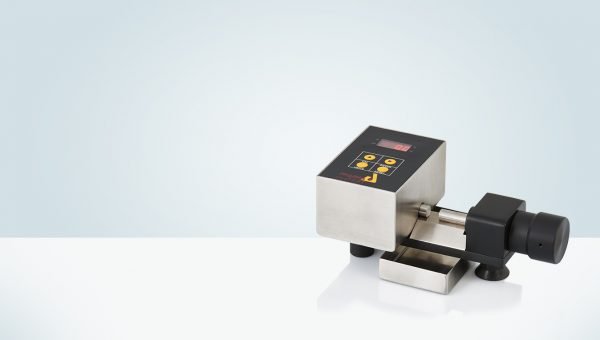
Manual Tablet Hardness Testing Instrument
PTB-M is a manual hardness testing instrument for tablets. The instrument is made in strict compliance with the EP <2.9.8> and USP <1217> Pharmacopoeia. PTB-M is very easy to use. Simply place the sample on the testing platform and rotate the knob manually. The jaw will move and force will be applied to the sample. The force is monitored electronically and displayed at the moment of breakage.
>Fully USP <1217> and EP <2.9.8> compliant
>Hardness Range: 5 N to approx. 300 N (500N optional)
>Accuracy: 0.1 N
>Resolution: 0.1 N/0.01 Kp
>Test tablet sizes of up to 28mm diameter
>Includes a 4 digit LED display and indicator for selected unit
>Connect PT-RP80 report printer to document the results (optional)
>Calibration program included
Advantages
>Compact, portable instrument
>Features the same high quality force sensor as other Pharma Test hardness testers
>Very easy to use, immediate results
>Entry of time and date
>Can be operated by 9V battery or using supplied power adapter
>Select result display unit from Newton (N), Kilopond (Kp), StrongCobb (Sc) and Pounds (Lb)
>Documentation of all results using the optional PT-RP80 report printer
>Easy to calibrate
| Parameter | Specification |
| Display | LED Display, 4 digits showing hardness result |
| Data Entry | Functional keys |
| Standard Force Range | 5.0 to approximately 300N (500N optional) |
| Accuracy | 0.1N |
| Maximum Sample Size | 28 mm diameter |
| Printer | Printer port to connect PT-RP80 report printer |
| Interface | RS-232 COM port |
| Calibration Guidance | Built-in calibration procedure for the digital load cell |
| Adjustments | Two point adjustment – zero and 10kg |
| Calibrations | Multiple point for load cell precision using certified weights (CAL15/30) |
| Force Detection Reproducibility | PT-MT3 Magnetic Tablet and suitable support |
| Bench Space Requirement | 275cm x 90 x 100 mm (Length x Width x Height) without external printer |
| Certification | All components certified to USP / EP requirements |
| CE / EMC Certification | All CE / EMC Certification provided |
| Validation | All IQ & OQ documents included |
Included in the Standard Scope of Supply
The PTB-M comes ready to use with the following standard scope of supply:
>Removable broken sample container and cleaning brush
>Power adapter
>Comprehensive documentation folder including:
>User manual
>QC/DQ testing certificate
>IQ documentation
>OQ documentation
>Conformity Declaration
>CE/EMC Declaration
>Instrument logbook
Options
In addition to the standard scope of supply Pharma Test offers a broad range of accessories and options including:
>500N (PTB-M500) extended force range
>PT-RP80 report printer to document results
>Recommended spare part set
>Full range of certified validation tools available
PTB 302 / PTB 502
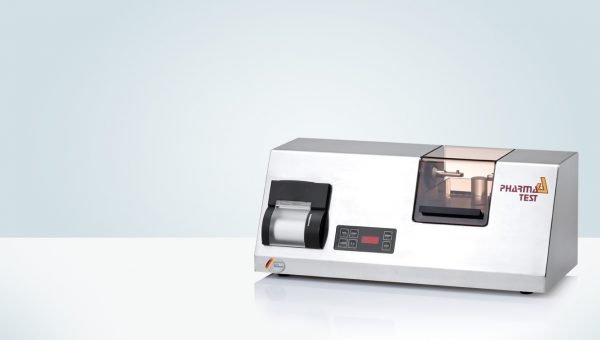
Manual Tablet Hardness Testing Instrument with Integrated Report Printer
The digital tablet hardness testing instrument PTB 302 features an integrated report printer. It is a single force mode hardness test apparatus adjusted for linear force increase while tablet hardness is tested. It offers a multiple point validation procedure for the built-in digital load cell. The instrument is made in strict compliance with the EP <2.9.8> and USP <1217> Pharmacopoeia.
>Fully USP <1217> and EP <2.9.8> compliant
>Single force mode instrument
>Integrated thermal printer
>Multiple point validation procedure built-in
>Adjustable linear force increase rate setting
Advantages
>No external printer required, this reduces the necessary bench space
>Documentation of all results using an integrated report printer
>Report printer uses less paper compared to a standard format printer
>Automatic re-start facility to speed up the testing sequence
>Validation and calibration program for the measurement station
>Dual point adjustment of the load cell for the hardness test station
>Multiple point validation (calibration)
>Data transfer via RS-232 interface
>Hardness testing in compliance with the EP <2.9.8> and USP <1217> Pharmacopoeia
| Parameter | Specification |
| Display | LED Display showing number of tests and hardness result |
| Data Entry | Numerical and Functional keys |
| Standard Force Range | 5.0 to approximately 300N |
| Accuracy | < 1N |
| Resolution | 0.074N (300N model) – 0.1482N (500N model) |
| Force Settings | Linear force increase |
| Selectable Range | 5.0 – 200 N/Second |
| Accuracy | < 2% force |
| Maximum Sample Size | 40 mm (Option 70mm) |
| Printer | Internal thermal printer |
| Interface | Serial RS-232 COM port |
| Calibration Guidance | Built-in calibration procedures the digital load cell |
| Adjustments | Two point adjustment – zero and 10kg |
| Calibrations | Multiple point for load cell precision using certified weights (CAL15/30/50) |
| Force Detection Reproducibility | PT-MT3 Magnetic Tablet |
| Instrument Housing | Stainless Steel to meet GLP requirements |
| Bench Space Requirement | 530 x 240 x 180 mm (Length x Width x Height) |
| Certification | All components certified to USP / EP requirements |
| CE / EMC Certification | All CE / EMC Certification provided |
| Validation | All IQ & OQ documents included |
Included in the Standard Scope of Supply
The PTB 302/502 comes ready to use with the following standard scope of supply:
>Standard jaw to allow hardness test of nearly all size and shape samples
>Broken sample collector
>10 rolls of printer paper
>Comprehensive documentation folder including:
>>User manual
>>QC/DQ testing certificate
>>IQ documentation
>>OQ documentation
>>Conformity Declaration
>>CE/EMC Declaration
>>Instrument logbook
PT-MT3
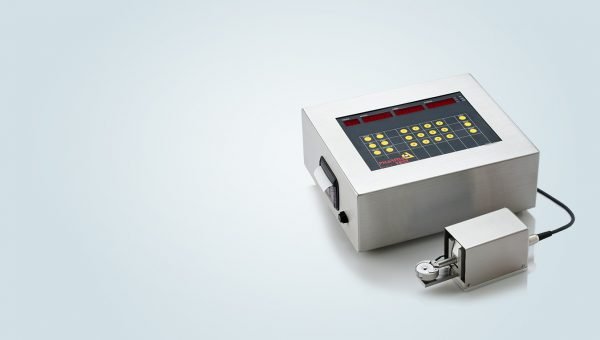
Magnetic Tablet for Dynamic Calibration and Periodical Qualification of Tablet hardness Testing Instruments
This instrument represents a tool for calibrating and qualifying the hardness range of Pharma Test and other brand tablet hardness testers. The PT-MT3 instrument has an electronically controlled and magnetically held “finger” made of stainless steel and a load cell attached to it.
>USP <1217> and EP <2.9.8> compliant for multiple point validation of hardness test instruments
>Hardness range: 5 N to approx. 500 N
>Hardness accuracy: ±1 N
>Break time setting: 0.10 to 99.59 seconds
>Break time accuracy: ±1 s
>Available supports: PTB 111E, PTB 111EP, PTB 302, PTB 311E, PTB 511E, PTB 420, PTB 420 Auto, PTB-M, WHT 3ME, PTBA 211E, supports for other brands available on request
>Calibration program included
Advantages
>Compact, portable instrument
>Built-in Thermo-Printer
>Very easy to use, immediate results
>Entry of time and date
>Easy to calibrate
| Parameter | Specification |
| Display | 4 LED Displays, showing Index, Mode, Time and Force |
| Data Entry | Functional keys |
| Standard Force Range | 5.0 to approximately 500N |
| Accuracy | ±0.1N |
| Breaking Time Setting | 0.10 – 99.59 sec. |
| Accuracy | ± 0.1 s |
| Printer | Built-in thermo-printer |
| Interface | RS-232 COM port |
| Calibration Guidance | Built-in calibration procedure for the digital load cell |
| Adjustments | Two point adjustment – zero and 10kg |
| Calibrations | Multiple point for load cell precision using certified weights (CAL15/30) |
| Bench Space Requirement | 300 x 250 x 130 mm (Length x Width x Height) without support |
| Net weight | Approximately 6 kg |
| Certification | All components certified to USP / EP requirements |
| CE / EMC Certification | All CE / EMC Certification provided |
Included in the Standard Scope of Supply
The PT-MT3 comes ready to use with the following standard scope of supply:
>Removable broken sample container and cleaning brush
>Power adapter
>Comprehensive documentation folder including:
>>User manual
>>QC/DQ testing certificate
>>IQ documentation
>>OQ documentation
>>Conformity Declaration
>>CE/EMC Declaration
>>Instrument logbook